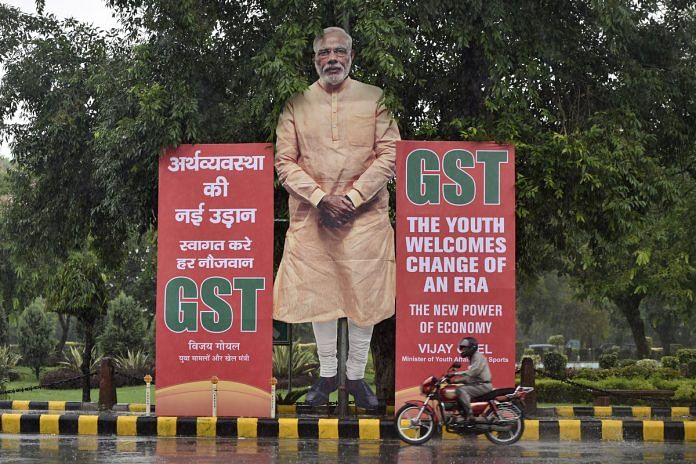Ahead of GST’s anniversary, policymakers say tax collections have risen in the past year and that teething issues have been addressed.
New Delhi: The contentious Goods and Services Tax (GST) celebrates its first birthday Sunday, and there’s good news and still some bad news.
The good news is that policymakers said that most thorny issues surrounding the new tax structure, which made headlines for much of last year, have been ironed out.
Also, tax collections have risen in the past year, ever since GST, touted as the biggest financial reform in independent India, came into effect at midnight on 1 July 2017.
The bad news is that a few concerns still remain, particularly on the tax bracket and on filing procedure.
Under GST, first mooted in 2007, there are four tax slabs — 5, 12, 18 and 28 per cent. There are, however, several items including food products, newspapers and even bindi and kajal that attract zero per cent tax while raw gold is taxed at 3 per cent.
Petroleum products and natural gas are also out of the GST ambit.
Many experts and businessmen have argued that multiple tax rates make it a flawed GST but then finance minister Arun Jaitley had pointed out before the launch that a country such as India, with its size and population, cannot have a single-rate GST.
Then there have been demands to remove many items from the highest tax bracket of 28 per cent. The Centre is looking into the demands but they may not be addressed in any hurry, a senior finance ministry official said.
“The issue is being looked into but we will have to give it a serious thought and in any case the decision will be taken by the GST Council,” the official said.
Discussions have also started to bring aviation turbine fuel and natural gas under GST net at the earliest. Sources, however, said the inclusion of petroleum products and alcohol may still take some time.
The council, the official added, will also look into the issue of filing of tax returns, which has continued to be a cause of concern for assesses. The filing system, which currently is fully online, may be tweaked to allow taxpayers, especially the small firms, to file returns manually.
Besides, the council is set to look into possible measures that can be adopted to further simplify the filing process.
The gains
The implementation of GST, which has subsumed a wide range of indirect taxes, is expected to boost economic growth. The economic survey projected a growth rate of 7-7.5 per cent for the current financial year. During the 2017-18 period, the growth rate is expected to be 6.7 per cent.
The new tax system has more-or-less stabilised after the initial hiccups, characterised by delay, confusion and disagreement. Tax collection for April exceeded Rs 1 lakh crore, and North Block officials are expecting the buoyancy to continue. More importantly, as many as 55 lakh new taxpayers have already come under the tax net and many more are likely to be added.
Vanaja N. Sarna, chairperson of the Central Board of Excise and Customs (CBEC), has maintained that any new overhauling structure takes time to settle down.
“It was natural to have teething problems but the fact that we have managed to more or less settle down within a year is an achievement in itself,” Soumya Kanti Ghosh, chief economic advisor, State Bank of India group, told the Print.
Off to a bad start
While Prime Minister Narendra Modi referred to GST as a “good and simple tax”, frequent changes in tax slabs, procedural norms, glitches in the portal supporting the GST Network, and the delay and uncertainty in disbursing refunds caused embarrassment to the government.
The government made it mandatory to file returns online to eliminate human intervention and to rule out discrepancies. But this increased the cost of compliance.
Those who felt the impact the worst were small businesses, which lacked the required wherewithal to comply with the stringent procedures and online filing. That apart, some of these businesses were still recovering from the aftermath of the demonetisation exercise.
Experts say that the hurried implementation of GST, without adequate preparations, led to gross mismanagement during the first few months. The switch to the new system led to massive confusion and harassment for both businesses and consumers in the initial months.
Subsequently, the glitch in the GST network portal, where all traders and business houses have to file returns, added to further confusion and panic. The country’s exporters too faced the brunt. The delay and uncertainty in their refunds caused damage to their businesses.
In other countries
Each country has different ways of implementing GST. Europe has between two and four rates, varying between 18 and 27 per cent depending upon the country.
UAE, on the other hand, has a single rate of 5 per cent. Malaysia switched to a single-rate GST of 6 per cent in 2015 but due to widespread protests, the tax structure has been scrapped recently.



